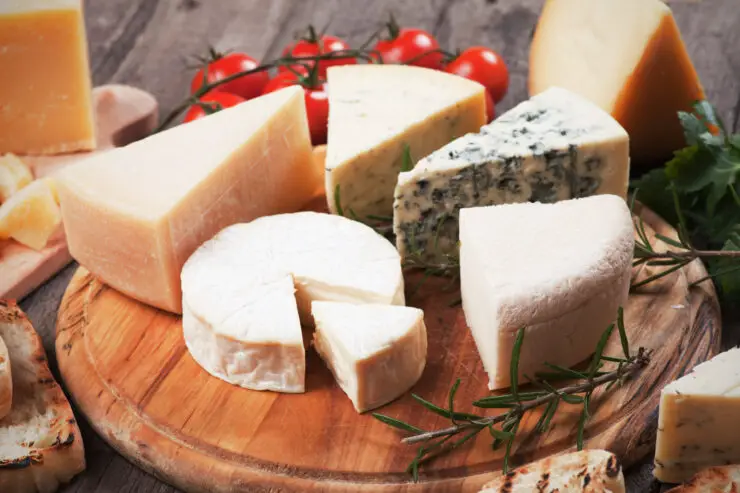As an Amazon Associate I earn from qualifying purchases. Please read the disclaimer for more info.
Italian cheese, with its wide range from soft to hard types, reflects Italy’s culinary heritage. Each has a unique flavor and texture, showcasing regional traditions and craftsmanship. Well-known cheeses like Mozzarella, Parmigiano-Reggiano, and Ricotta play key roles in Italian and global cuisines.
The diverse geography of Italy contributes to the distinct traits of its cheeses. The north produces soft cheeses like Mascarpone, while the south is known for harder cheeses like Pecorino Romano. These cheeses are more than food; they represent Italian culture and values.
Different Italian cheese types suit different dishes. For instance, Provolone can be melted on sandwiches, Gorgonzola can be sprinkled on salads, and Taleggio can be enjoyed with wine.
Each cheese offers a taste of Italy’s gastronomic history.
- 10 Best Italian Cooking Vacations 2024: Buon Appetito
- 7 Best Tuscany Cooking Vacations 2024: A Taste of Tuscany
- 10 Best Cooking Classes in Rome for Italian Cuisine Lovers
Iconic Italian Cheese types
Italian cheeses are as diverse as the regions from which they come, offering a rich palette of flavors, textures, and uses. Understanding the variety on offer can elevate your dining experience, provide culinary inspiration, and deepen your appreciation for Italy’s gastronomic heritage.
Hard Cheeses
Hard Italian cheeses, from parmesan cheese to Pecorino Romano, are renowned for their bold flavors and firm textures.
Parmigiano-Reggiano
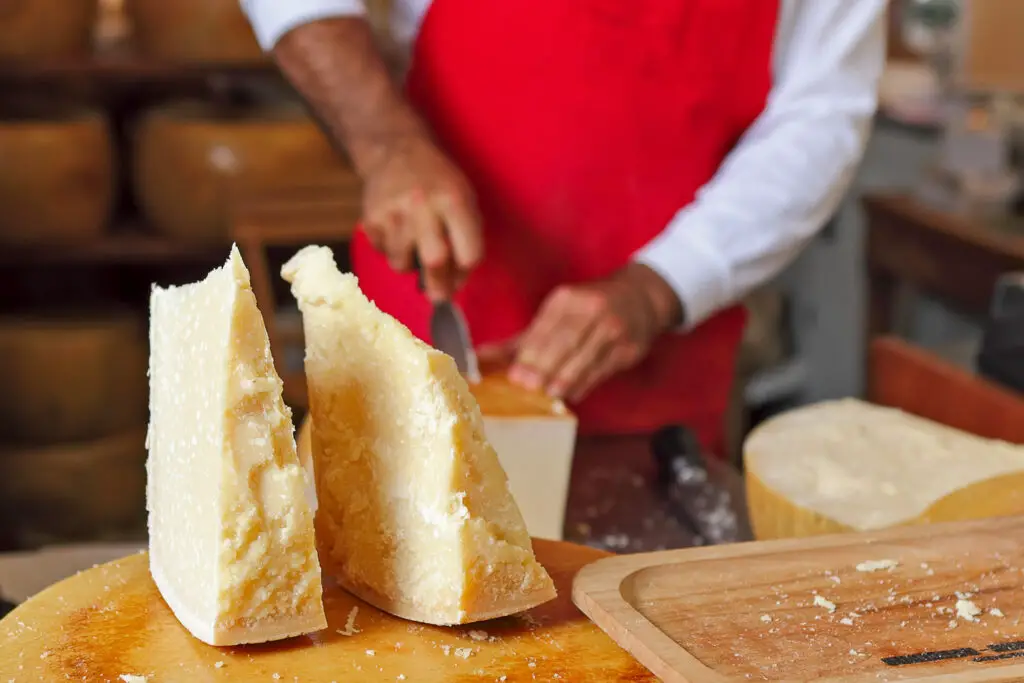
Parmigiano-Reggiano, often called ‘The King of Cheeses’, is renowned for its rich, savory flavor and slightly granular texture. It’s made exclusively in the provinces of Parma, Reggio Emilia, Modena, and parts of Bologna and Mantova.
Parmigiano-Reggiano is typically aged 12 to 36 months, resulting in a deep, complex flavor profile ranging from nutty to sharp. Its distinctive taste and crystalline texture make it a versatile ingredient, perfect for grating over pasta, sprinkling on salads, or simply enjoying on its own with a drizzle of honey or balsamic reduction.
The production of Parmigiano-Reggiano is protected by European law, ensuring that only cheeses that meet strict artisanal standards can bear the name.
Grana Padano
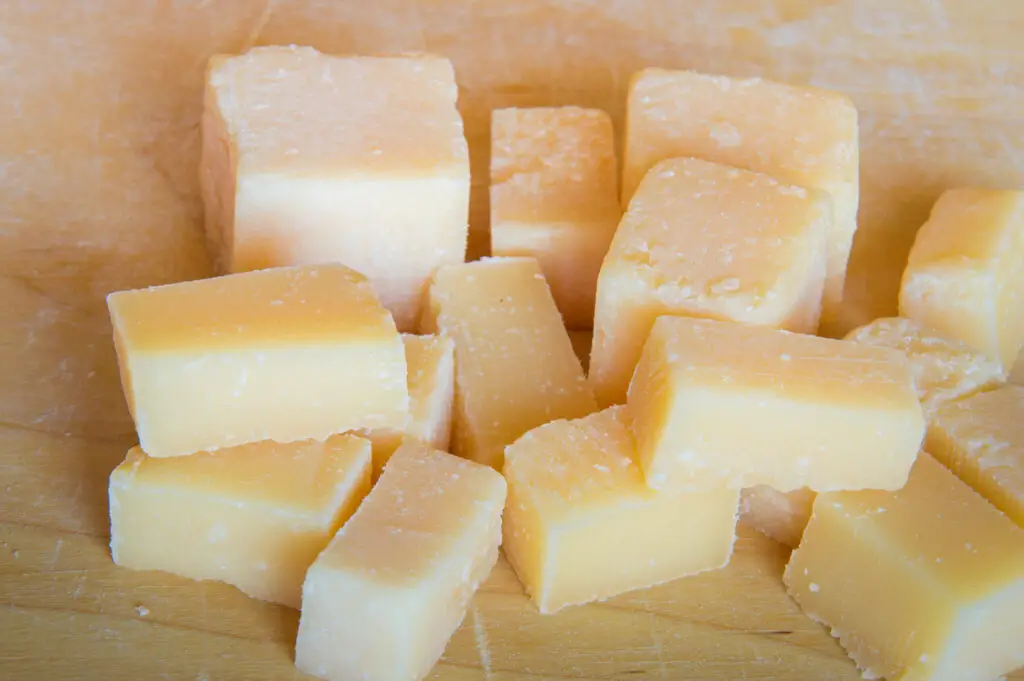
Grana Padano has a rich and full-bodied flavor that deepens with age. Originating from the Po River Valley in northern Italy, this hard, grainy cheese is made from partially skimmed cow’s milk, which gives it its characteristic light, nutty taste.
Grana Padano is often compared to Parmigiano-Reggiano due to their similar production methods and flavor profiles, but Grana Padano has a slightly milder, less sharp flavor.
The cheese is typically aged 9 to 24 months, resulting in a texture ranging from creamy to crumbly. The rind is thick and smooth, bearing the distinctive Grana Padano seal as a guarantee of its quality and authenticity.
Whether it’s grated over pasta, sliced onto a cheese board, or paired with fruits and nuts, Grana Padano adds a touch of elegance and a burst of flavor to any dish.
Pecorino Romano
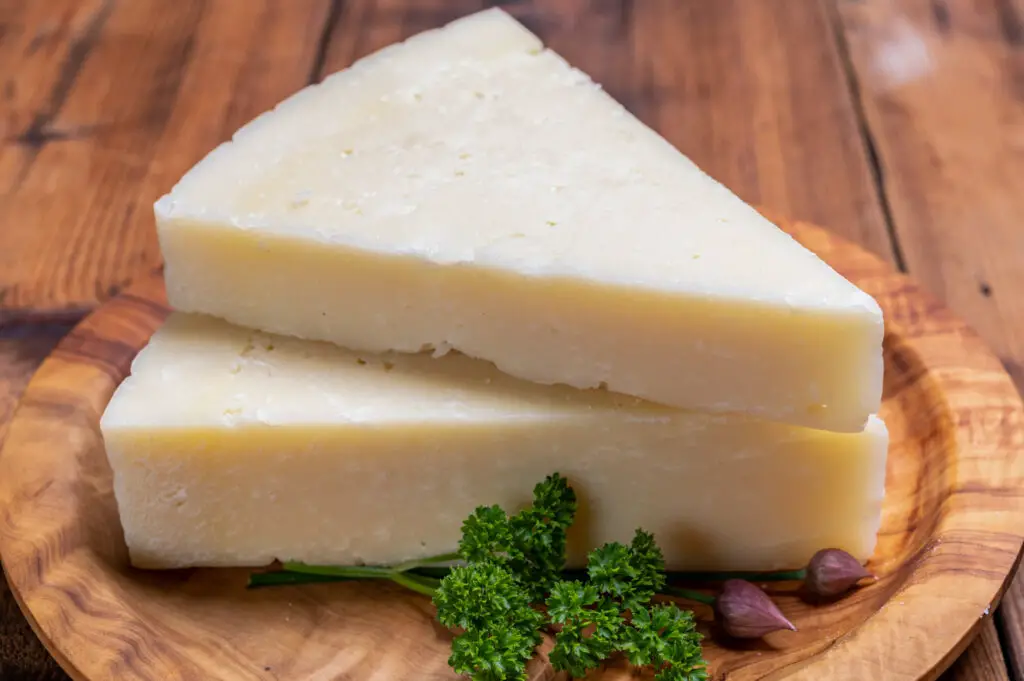
On the other hand, Pecorino Romano is a different cheese type primarily derived from sheep’s milk. This cheese is characterized by its salty taste, which sets it apart from Parmesan and Grana Padano.
Pecorino Romano’s distinctive flavor can provide an interesting contrast in dishes and particularly appeal to those who enjoy robust, salty cheeses.
Related: 15 Best Italian Cookbooks for Authentic Italian Recipes
Semi-Soft to Soft Choices
Fontina
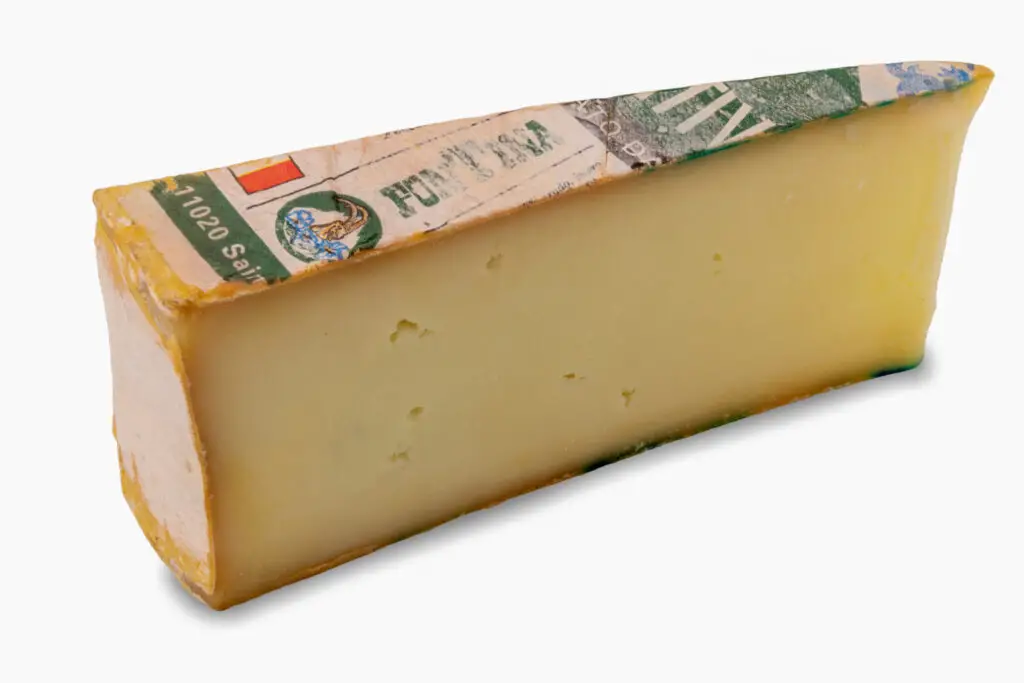
Fontina cheese is a classic Italian cheese hailing from the Aosta Valley in the Alps. This semi-soft cheese is made from cow’s milk and is renowned for its exceptional melting qualities, making it a favorite choice for fondue and gourmet grilled cheese sandwiches.
Fontina has a smooth, creamy texture and a slightly nutty flavor that becomes more pronounced when aged. Its rind is typically tan to orange-brown, while the interior of the cheese is pale cream in color with tiny holes scattered throughout.
Fontina cheese is versatile and can be enjoyed in a variety of ways – it’s delicious when sliced and paired with fresh fruits and crusty bread, melted into pasta dishes, used in baking, or for the ubiquitous grilled cheese sandwich.
The authentic Italian Fontina has a distinctive taste and is marked with a Matterhorn stamp, including the label “Fontina.”
Asiago
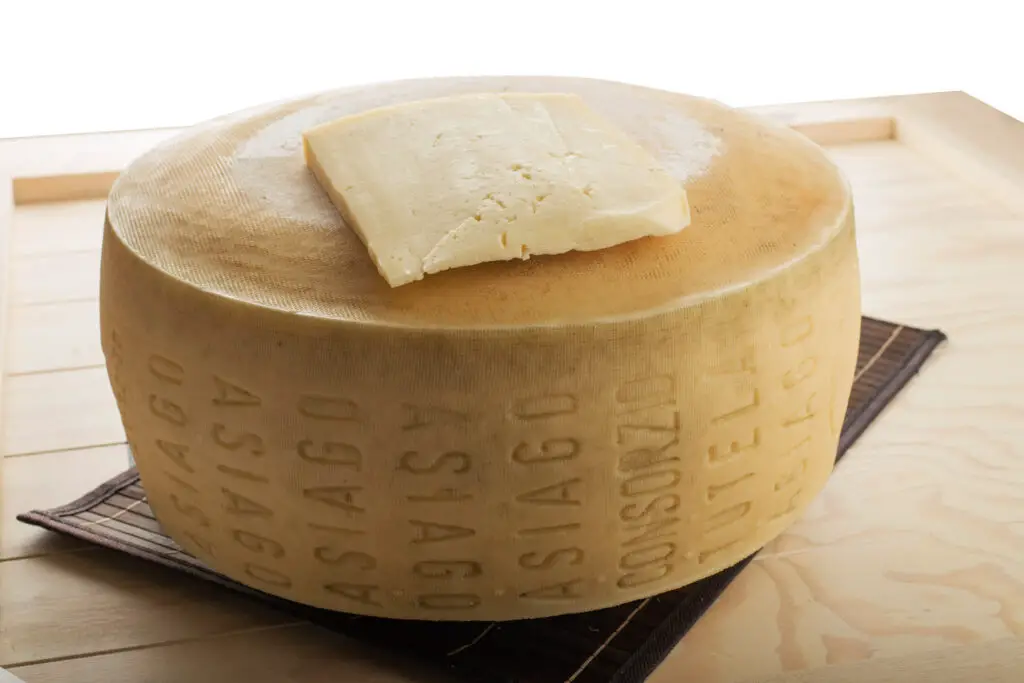
Asiago cheese hails from the Veneto and Trentino regions. Made from cow’s milk, Asiago comes in two varieties – Asiago Pressato, which is fresh and smooth with a slightly sweet taste, and Asiago d’allevo, which is mature and has a more robust flavor.
The latter can be further classified based on aging into Mezzano (4-6 months), Vecchio (over 10 months), and Stravecchio (over 15 months).
Aged Asiago cheese possesses a crumbly texture and a rich, nutty, and slightly piquant flavor. It is often used grated over pasta, salads, and soups.
On the other hand, Fresh Asiago has a soft, creamy texture and a milder flavor, making it an excellent table cheese that pairs well with fruits and white wines.
The rind of Asiago cheese is typically marked with the product’s name, origin, and the dairy number to ensure its authenticity.
Taleggio
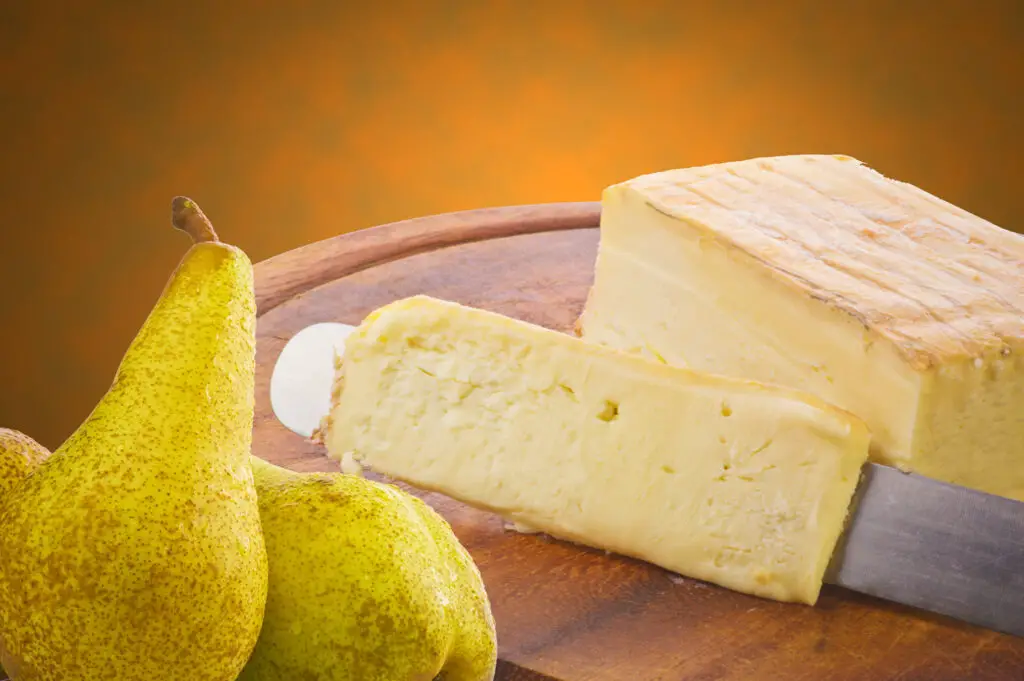
Taleggio is another variety of Italian cheese that’s highly prized amongst cheese enthusiasts. Despite its pungent aroma, which may seem overpowering at first, Taleggio is loved for its smooth, buttery texture and complex flavor.
It’s a versatile cheese that can be enjoyed on its own or used in various dishes. Still, it’s perhaps most commonly found as a standout addition to any cheeseboard, where its unique characteristics can truly shine.
Fresh and Creamy Varieties
Mozzarella
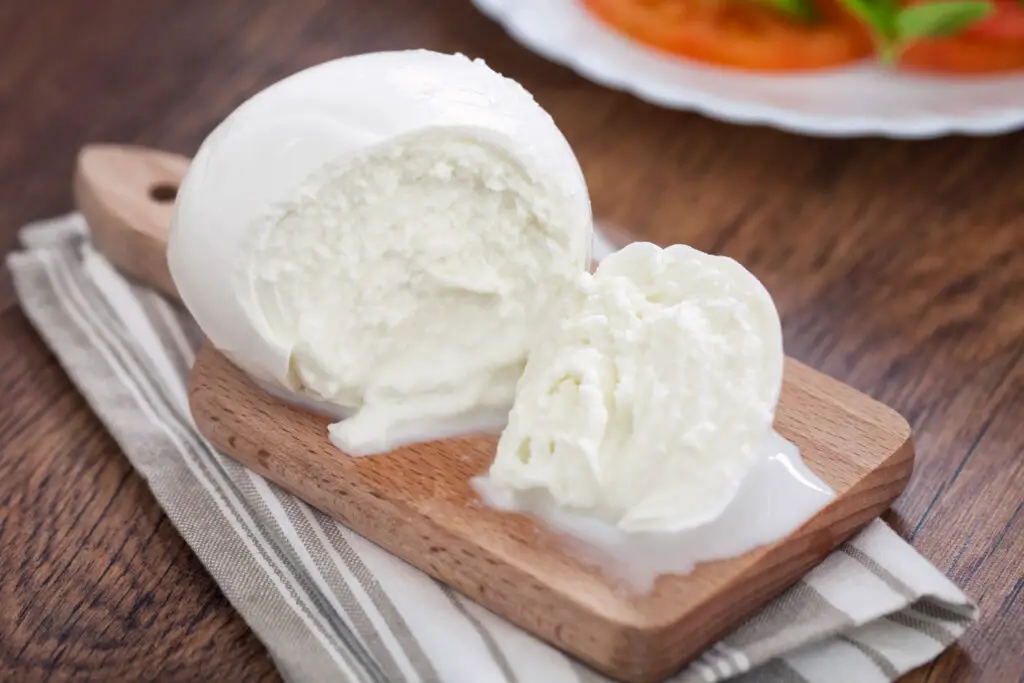
Mozzarella is a versatile cheese that’s often used in a variety of culinary applications. Its mild, milky flavor and elastic texture make it popular for pizza and caprese salad dishes. A particularly notable variant is Mozzarella di Bufala. This cheese is made from buffalo milk, giving it a richer and creamier texture than mozzarella made from cow’s milk.
Its distinct, slightly tangy flavor sets it apart and makes it a sought-after choice for those seeking a more refined taste experience.
Mozzarella, Burrata, and Ricotta are fresh cheeses that offer a delightful taste of Italy. They are characterized by their mild flavor profiles and soft, creamy textures.
Burrata
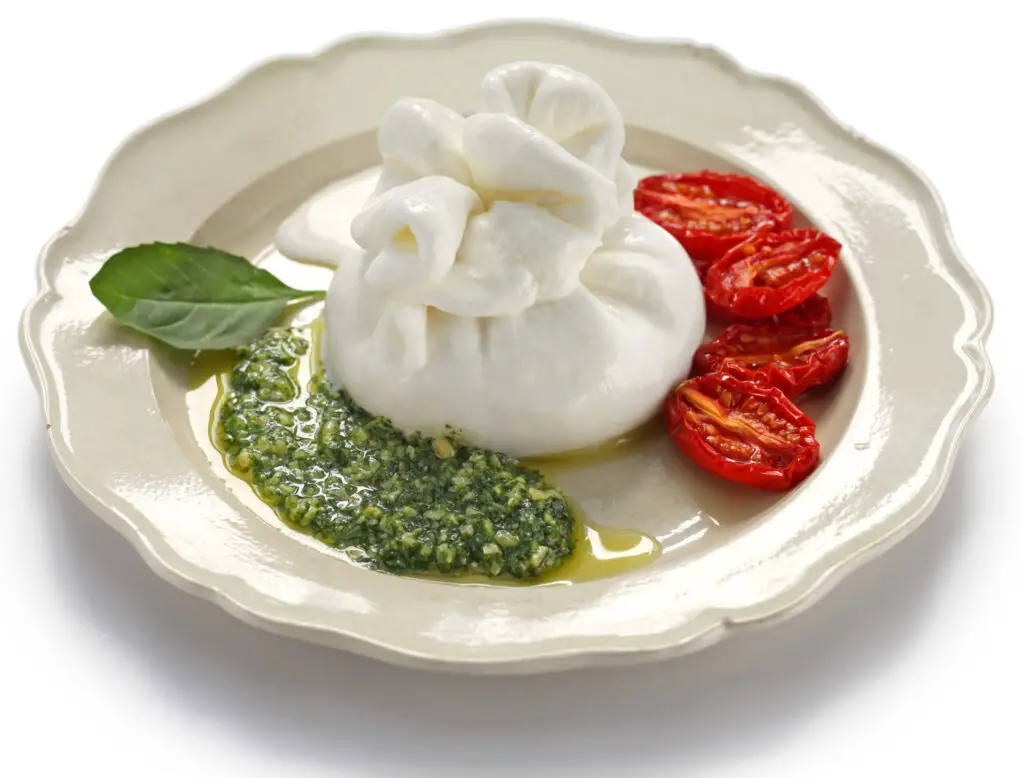
Burrata is another fresh, soft Italian cheese that’s loved for its unique texture and taste. Its outer shell is made of solid mozzarella, while the inside contains stracciatella and cream, giving it an incredibly soft, creamy interior.
Burrata di Andria is a prime example of this cheese, renowned for its supple texture and subtly sweet, milky flavor. It’s often enjoyed fresh, drizzled with olive oil, and sprinkled with salt.
Stracciatella
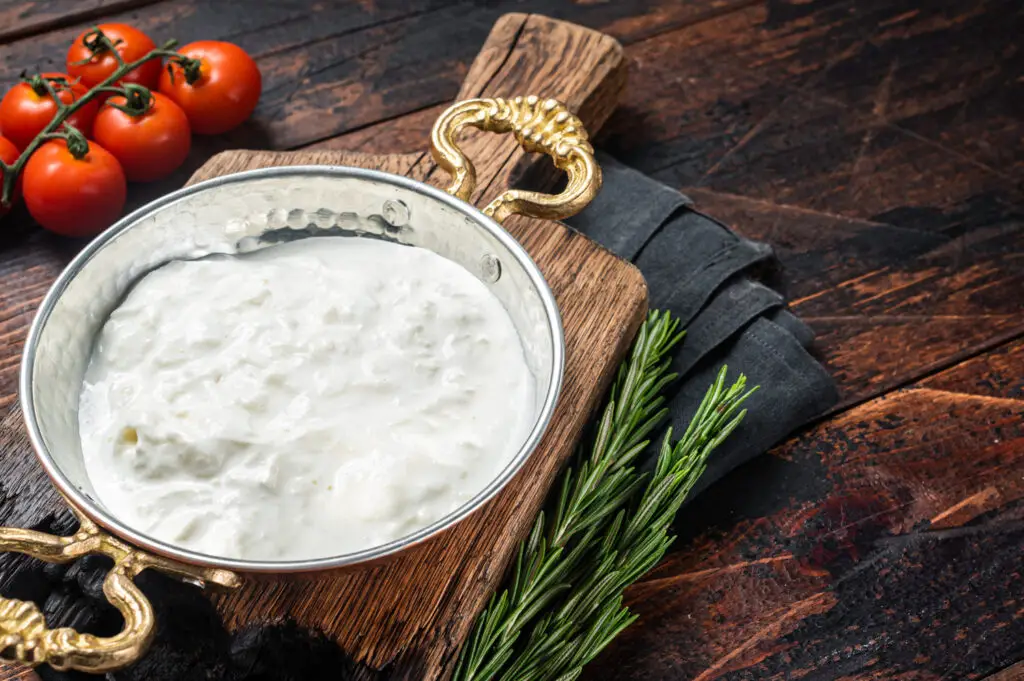
Stracciatella cheese is a fresh, soft Italian cheese originating from the Puglia region. The term “stracciatella” translates to “shredded” in English, aptly describing the cheese’s unique texture.
It’s made by mixing shreds of mozzarella cheese with fresh cream, resulting in a rich, creamy, and stringy texture. Stracciatella boasts a delicate, milky flavor that pairs wonderfully with a wide range of dishes.
It’s often served as an antipasto with crusty bread, spooned onto salads, or used to enrich pasta dishes. Its freshness and luscious creaminess make stracciatella a cherished gem in Italian cuisine.
Ricotta
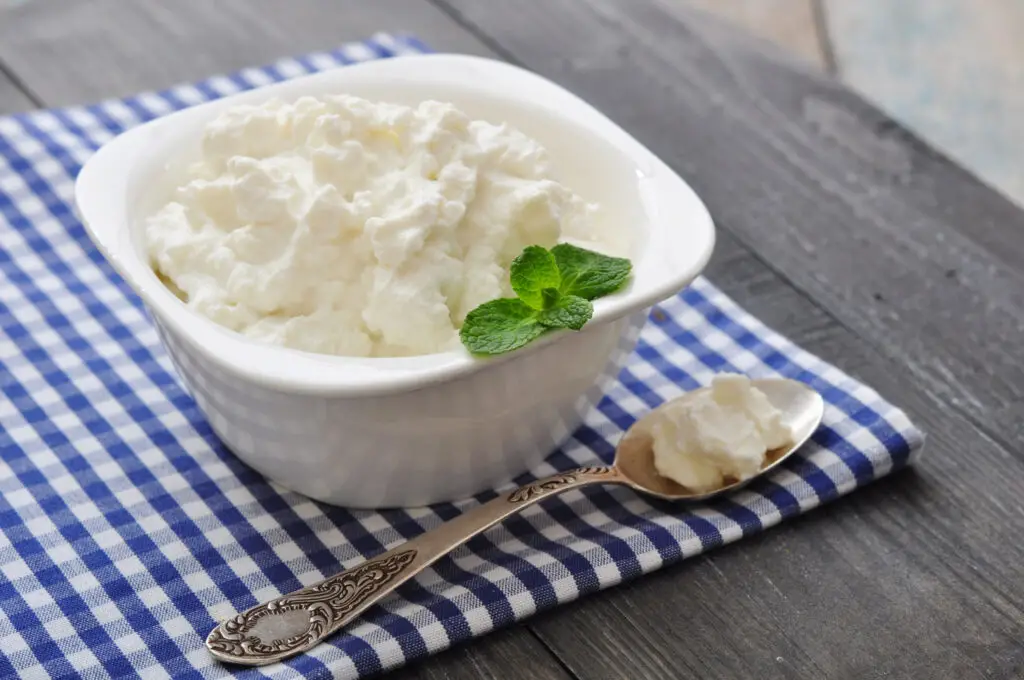
Ricotta is a cheese made from the whey left over from the production of other cheeses. It has a light, slightly sweet flavor, and a grainy texture. Ricotta is incredibly versatile and can be used in savory and sweet dishes, from lasagna to cheesecake.
Distinctive Blue-veined Cheeses
Gorgonzola
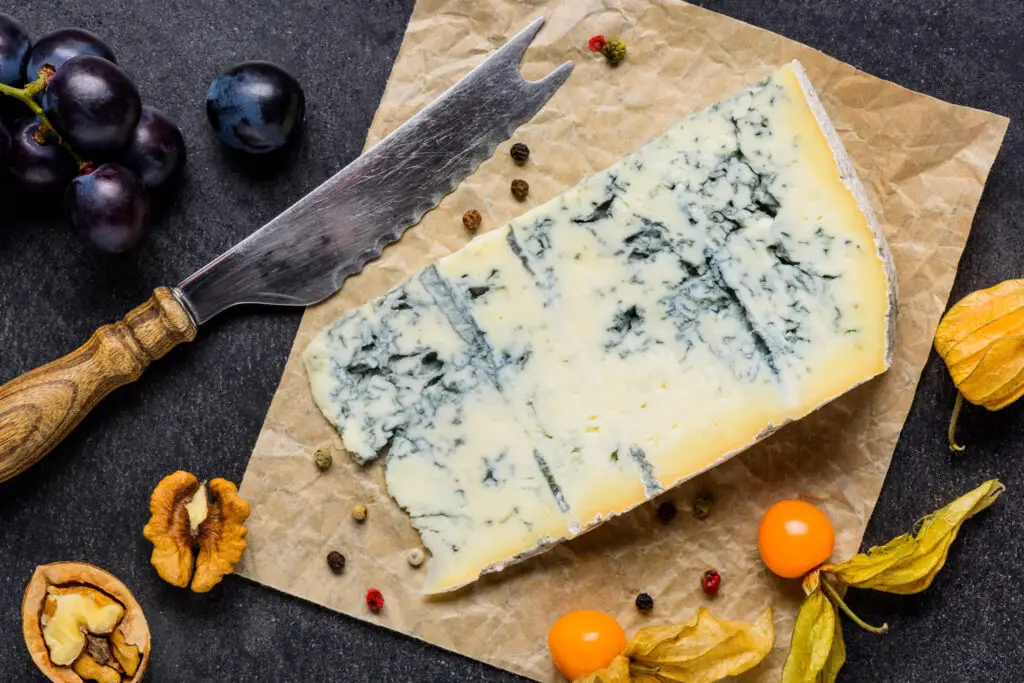
Gorgonzola, a famous Italian blue cheese, is known for its distinct flavor and texture. This cheese is typically categorized into two main types: Dolce and Piccante.
The Dolce variety of Gorgonzola is known for its creamy texture and mild flavor. This cheese is generally younger and aged for about two to three months.
It has a soft, almost spreadable texture, perfect for spreading on crackers or melting into sauces.
Despite being a blue cheese, Gorgonzola Dolce is surprisingly gentle on the palate, offering a sweet, milky flavor that’s well-balanced by the subtle tanginess of the blue mold.
On the other hand, Gorgonzola Piccante, also known as Gorgonzola Naturale, offers a stronger, sharper flavor compared to its Dolce counterpart.
Aged over three months and sometimes up to a year, this cheese has a firmer texture and a more pronounced, piquant flavor. The characteristic blue veins from the Penicillium roqueforti mold are more prominent in this variety, contributing to its robust taste.
Both varieties of Gorgonzola cheese feature distinctive blue-green streaks or spots caused by the Penicillium roqueforti, a type of mold that’s responsible for the unique characteristics of blue cheeses.
Whether you prefer the creamy, mild taste of Dolce or the sharper, more intense flavor of Piccante, Gorgonzola offers a unique taste experience that’s rich in tradition and flavor.
Smoked and Seasoned Selections
Provolone
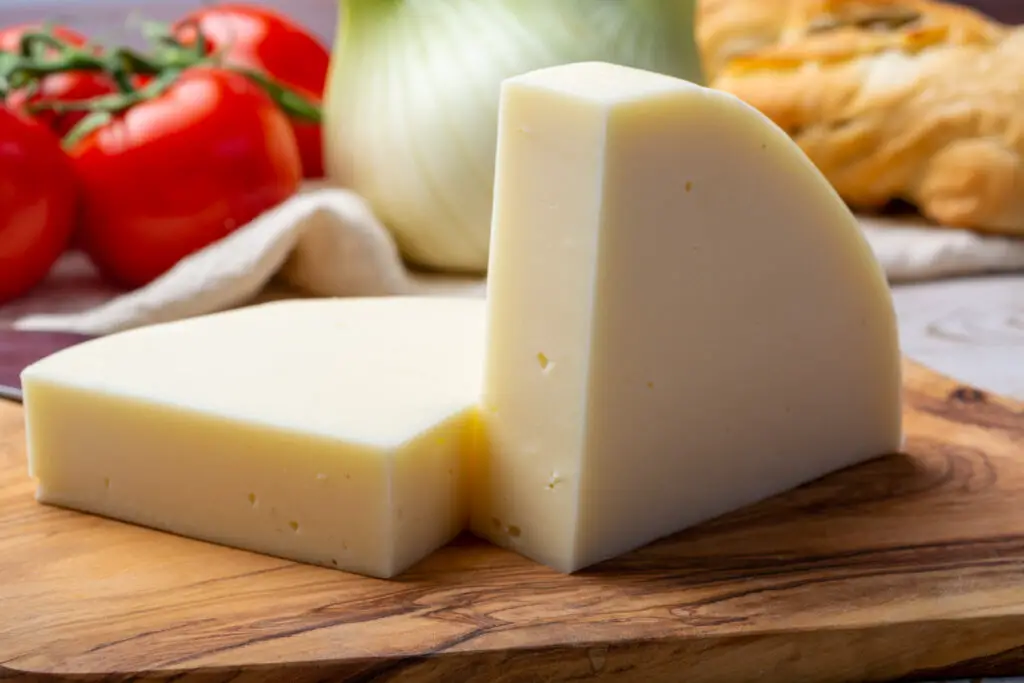
Provolone is a semi-hard cheese made from cow’s milk. It’s typically aged for two to three months, resulting in a pale yellow color and a mild, slightly tangy flavor.
However, some varieties of Provolone are smoked, which lends the cheese a deeper, more complex flavor profile.
The smoking process involves exposing the cheese to smoke from burning wood or other natural materials, imparting a smoky taste and aroma. This enhances the cheese’s original flavor and gives it an added depth that can elevate any dish it’s used in.
Scamorza
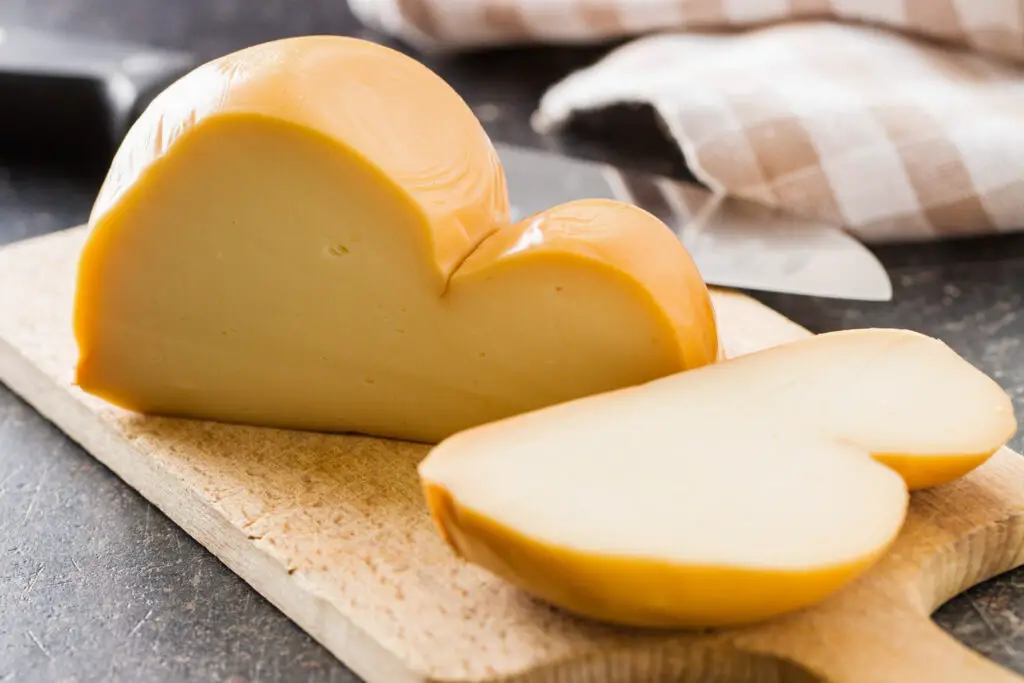
Scamorza is another Italian cheese that’s often smoked. This cheese is similar to mozzarella and is made by stretching and then hanging the cheese to dry. Scamorza takes on a golden-brown color and a distinct smoky flavor when smoked.
The texture of Scamorza is firmer than mozzarella, which makes it a good candidate for grilling.
Smoked Provolone and Scamorza can be enjoyed in a variety of ways. They can be served as part of an appetizer platter, paired with fruits, nuts, and a selection of cured meats.
They also make a flavorful snack or melt on top of crackers or bread.
Additionally, these cheeses can be used in cooking, where their smoky flavor can add a new dimension to dishes like pasta, pizza, and sandwiches.
Despite the strong flavor, they don’t overpower other ingredients, making them a versatile addition to many recipes.
Lesser-known Delicacies
Provolone Valpadana
This variant of Provolone cheese is known for its spicy kick. Made in the Val Padana region of Italy, this semi-hard cow’s milk cheese is often paired with fruits or wine. It’s matured for at least two months, during which it develops a sharp, tangy flavor.
Bitto
Bitto is a sweet and creamy cheese that hails from the Lombardy region. It’s made from a mix of cow’s and goat’s milk and is aged for at least 70 days to several years. The flavor intensifies with age, becoming more complex and piquant while maintaining a sweet undertone.
Bel Paese
Named after a patriotic book meaning “Beautiful Country,” Bel Paese is a semi-soft cheese known for its mild, buttery flavor. It’s made from cow’s milk and has a smooth, creamy texture.
Robiola
This soft-ripened cheese is typically made with varying proportions of cow’s, goat’s, and sheep’s milk, offering a rich, tangy flavor. Robiola cheeses can range from smooth and creamy to crumbly and slightly pungent depending on their blend of milk and aging process.
Bra
Coming from the town of Bra in Cuneo, Piedmont, this cheese can be made from cow’s, goat’s, or sheep’s milk. There are two types: “Bra d’alpeggio” is made in the mountains during the summer months and has a more robust flavor, while “Bra tenero” and “Bra duro” are softer or harder versions with milder flavors. It’s often used in fondue or risotto.
Casatica
This is a soft, creamy cheese made from buffalo milk in Lombardy. It has a delicate, slightly sweet flavor and a velvety texture. Sciatica is perfect for melting over pasta or risotto or enjoyed with crusty bread and a glass of wine.
Exploring these cheeses offers a delightful journey for the palate, each one bringing a unique taste of Italy’s rich cheese-making tradition.
Understanding Italian Cheese
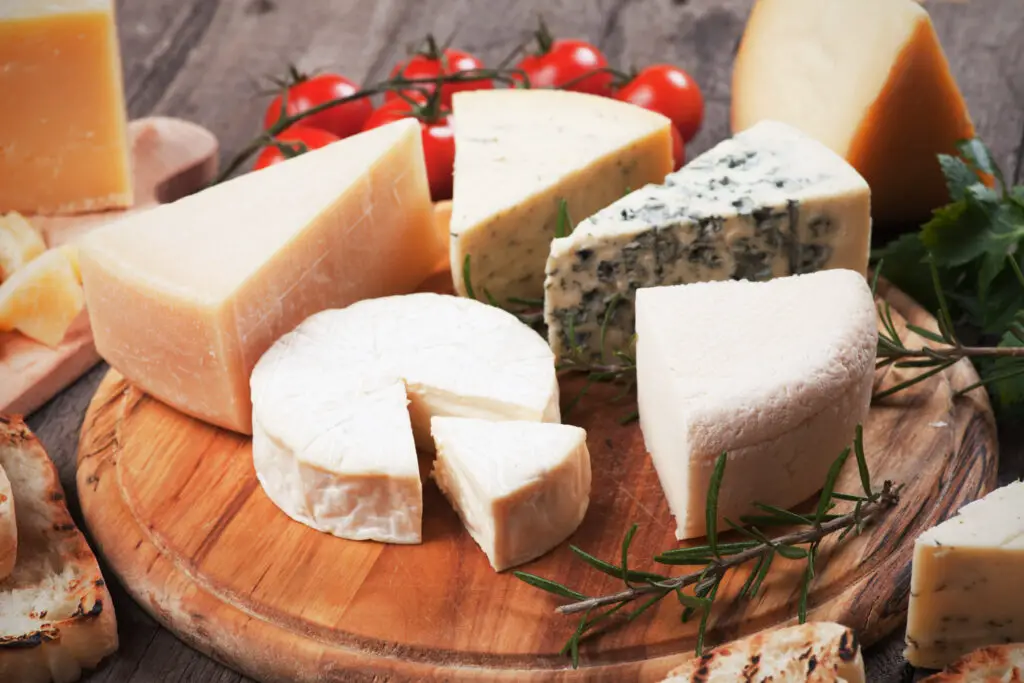
Italian cheese is diverse and integral to culinary tradition. Ranging from the mountainous north to the sun-kissed south, each region imparts unique characteristics to its cheeses. Let’s dive into the details to appreciate the full landscape of Italian cheese.
DOP Certified Cheeses
DOP (Denominazione di Origine Protetta) certification ensures the quality and authenticity of cheeses such as Parmigiano Reggiano, Gorgonzola, Mozzarella di Bufala, and Burrata di Andria, tying them to their regional origins.
Types and Categories
Italian cheeses come in various forms: soft, semi-soft, hard, and blue cheese. A classic soft cheese is Mozzarella, while Provolone is a popular semi-soft option. Parmigiano Reggiano is an undisputed champion for hard cheese, and Gorgonzola stands out amongst blue cheeses.
Production Regions
Italy’s topography influences where specific cheeses are produced. Alpine regions like Lombardy, Aosta Valley, and Piedmont are known for hard, aged cheeses, while Southern Italy, including Campania and Basilicata, favors fresh, soft varieties.
Pairing Italian Cheese Types
Pairing Italian cheeses with the right counterpart, whether it’s wine, food, or even olive oil, elevates the taste experience. You’ll discover the interplay of flavors that Italian cuisine champions. Let’s explain how to match these cheeses to enhance your appetizer, main course, or dessert.
Wine and Cheese Harmony
Prosecco is light and bubbly, perfect for a young Mozzarella or creamy Ricotta. For a bold Parmigiano-Reggiano, opt for a full-bodied Barolo. Love Chianti? Pair it with a slice of Pecorino to bring out the earthy notes. If you’re indulging in a richer cheese like Gorgonzola, seek out the sweet balance of an Amarone.
Cheese and Food Combinations
Antipasti often start with cheese. A versatile Provolone works well in salads or as a snack. Fresh pasta? Shave some Grana Padano on top. Asparagus spears wrapped in slivers of Fontina make a heavenly appetizer. For pizza, go with Mozzarella, and nothing beats Ricotta layered in your lasagna.
Cheeseboards and Presentation
A visually appealing cheeseboard is essential when serving Italian cheeses. Start with a block of Parmesan, add clusters of Gorgonzola and some fresh Burrata. Pair these with Italian olives, thin prosciutto slices, and a drizzle of extra-virgin olive oil. Remember to vary texture and flavors, and give each cheese ample space to stand out.
If you enjoyed this post on Italian cheese types, you might enjoy one of these:

